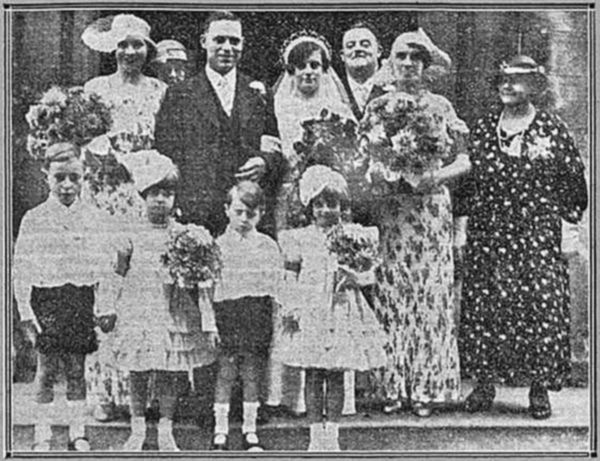Macey and Scott Family
The Society is very grateful to Myra Scott for sharing so many of her memories and family records that bring this story to life.
| 1. Introduction | 7. Family Tree - Macey Family |
| 2. Marriage: George Archibald Macey and Gladys May Hudson | 8. Family Tree - Hudson Family |
| 3. Marriage: Walter Frederick Macey to Dorothy Eileen Hudson | Scrapbook of Stedlyn greyhound breeding (opens a new page) |
| 4. Marriage: Florence Ivy Hudson and Thomas Richard Oakley | Dr Who in Lynsted... from the Dr Who Magazine |
| 5. More about Myra's father in wartime | |
| 6. Husband, Len Scott's devotion to the Lynsted Church Clock | Archaeological Survey of Stelyn Retreat (2004) - required prior to site development of St Paul's Court |
Introduction
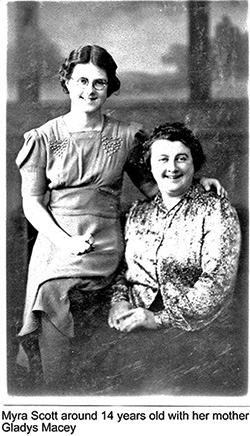 Myra Scott tells us the wider story of the Macey and Scott families and their connection with the Parish. A story that takes in Dover, Faversham, Teynham and travels through a fishmonger's business in Greenstreet, a residence behind The George Inn, No.1 Lynsted Lane, and latterly the residences and several business ventures established in Lynsted Village; never forgetting the church clock that received so many years of love and professional care from Myra's late husband, Len Scott (bottom of this page).
Myra Scott tells us the wider story of the Macey and Scott families and their connection with the Parish. A story that takes in Dover, Faversham, Teynham and travels through a fishmonger's business in Greenstreet, a residence behind The George Inn, No.1 Lynsted Lane, and latterly the residences and several business ventures established in Lynsted Village; never forgetting the church clock that received so many years of love and professional care from Myra's late husband, Len Scott (bottom of this page).
George Macey (whose father was also called George), volunteered at the age of 14 (by lying about his age) to serve as drummer in Ireland. He then became a drummer in Dover. The family story then follows George after he leaves the Army. He walked from Dover to Lynsted with a cart from which he sold fish. On arriving in Greenstreet, he settled to open a fish-shop opposite the old Fox Inn. This forms one of Myra Scott's earliest memories at the age of 3.
This linkage with Greenstreet is reinforced, very touchingly, in a Bible entry belonging to Myra's uncle, Charles Macey - with inscription (in case he didn't return from the First World War):
"Should the Bible be found - Please return to Mrs G Macey, Greenstreet hill, Greenstreet, Near Sittingbourne"
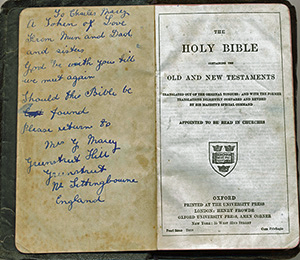 Relatively few official records survive from those who fought in the First World War, but some for Charles do survive. Those documents reveal that Charles enlisted on 19th February 1916. Recruited in Sittingbourne, he initially joined the 3rd Battalion (Official Reserve), The Buffs (East Kent Regiment - Regimental Number 25254) giving his age correctly as 18 years and 78 days. Both he and George (his brother) earned the Victory and British medals. He was then mobilised from the Reserve on 30th August 1916 and posted the the Queens Royal West Sussex No.1 Depot Company. He was then transferred to the 20th Middlesex Regiment. Later he suffered a gun-shot wound to his right arm (3rd August 1818) and returned home. His medical record shows he suffered considerable deafness and was declared "fit for labour purposes" - Class A3. He then joined the 5th Labour Battalion (Regimental Number 157362). He served in France.
Relatively few official records survive from those who fought in the First World War, but some for Charles do survive. Those documents reveal that Charles enlisted on 19th February 1916. Recruited in Sittingbourne, he initially joined the 3rd Battalion (Official Reserve), The Buffs (East Kent Regiment - Regimental Number 25254) giving his age correctly as 18 years and 78 days. Both he and George (his brother) earned the Victory and British medals. He was then mobilised from the Reserve on 30th August 1916 and posted the the Queens Royal West Sussex No.1 Depot Company. He was then transferred to the 20th Middlesex Regiment. Later he suffered a gun-shot wound to his right arm (3rd August 1818) and returned home. His medical record shows he suffered considerable deafness and was declared "fit for labour purposes" - Class A3. He then joined the 5th Labour Battalion (Regimental Number 157362). He served in France.
Thankfully, he did survive and Mrs Macey moved at some time to 1 Lynsted Lane (behind The George Inn).
Amongst the images shared with the Society are the wedding photographs of Gladys May Hudson and George Archibald Macey, 26th December 1927, in Dover. Society research has uncovered a full newspaper report (below) that gives an insight into "setting up home" in the 1920's. George's brother, Walter Frederick, also married into the Hudson family - Dorothy Eileen Hudson (newspaper report, below).
Marriage: George Archibald Macey and Gladys May Hudson (26th December 1927)
| Dover Express of 6th January 1928 |
MR. G. A. MACEY - MISS G. M. HUDSON. The wedding took place on Boxing Day, at St. Andrew's Church, Dover, of Miss Gladys May Hudson, daughter of Mr. and Mrs. V.A. Hudson, to Mr. George Archibald Macey, son of Mr. and Mrs. G. Macey, of Teynham. The officiating clergyman was the Rev.C.H. Bailey. The bride, who was given away by her father, wore a dress of white crepe-de-chine with silver lace, a Russian headdress of orange blossom and a veil, silver shoes to match the lace, and carried a shower bouquet. The bridesmaids were the Misses Ivy and Dorothy Hudson, sisters of the bride; Miss Dorothy Albrow and Miss Rosie Hudson, cousins of the bride; and Miss Hilda Macey and Miss Gladys Stevens, sister and niece of the bridegroom. The elder maids wore dresses of peach crepe-de-chin, silver headdresses, and carried bouquets to match their frocks, while the two younger ones wore dresses of white silk and Dutch caps. The best man was Mr. Walter Macey, brother of the bridegroom. After the ceremony, a reception was held at 31, London Road. The honeymoon was spent at Teynham, the bride going away in a dove grey coat trimmed with fur, shoes and stockings to match, and a pink hat trimmed with gold. The taxis were supplied by Mr. H.J. Sawyer, of the Maroon Hire Service, High Street. Mr. and Mrs. G.A. Macey were the recipients of many presents, including the following:- |
|
Marriage: Walter Frederick Macey to Dorothy Eileen Hudson (21st September 1935)
| Dover Express of 27th September 1935 |
MR W. F. MACEY - MISS D. E. HUDSON
The wedding took place on Saturday, at Buckland Church of Miss Dorothy Eileen Hudson, third daughter of Mr. and Mrs. V.Hudson, of 250, London Road., to Mr. Walter Frederick Macey, third son of Mr. and Mrs. G.Macey, of Teynham. The Rev. G.J.Browne officiated. The bride, who was given away by her father wore a dress of white satin, a wreath of orange blossom and veil and white satin shoes. She carried a bouquet of red roses. The bridesmaids were Miss E.Keeler (chief) and Miss M.Chidwick (friends of the bride), Miss.M.Macey (bride's niece) and Miss B.Hamilton (bride's cousin), Master G.Saunders (nephew of the bridegroom) and Master D.Penn (cousin of the bride) were page boys. The two elder bridesmaids wore floral dresses with hats to match and silver shoes, and carried bronze and yellow chrysanthemums, and the two little ones wore yellow organdie dresses with little caps to match, and white shoes and socks. The little page boys wore white satin blouses and black velvet knickers. Mr. A.Gordon was the best man. A reception was held at St. Barnabas' Hall, Barton Road. The honeymoon was spent at Sittingbourne, the bride going away in a blue marocain dress with a nigger brown coat and a Marina hat to match. The cars were supplied by the Priory St.Garage, Mr an Mrs. W.F.Macey were the recipients of many useful presents. |
[Society Note: This was the first time Myra was a bridesmaid at five years old - she is second from the left in the front row.]
Marriage of Florence Ivy Hudson - Monday, 8th January 1934
The middle of the three Hudson daughters, Florence Ivy Hudson, also had her wedding recorded.
| Dover Express of 19th January 1934 |
| MR T.R. OAKLEY - MISS F.I. HUDSON. The wedding took place on January 8th, at St. Andrew's Church, Buckland, Dover, of Miss Florence Ivy Hudson, daughter of Mr. and Mrs V.Hudson of London Road, Dover, to Mr. Thomas Richard Oakley, son of Mr. and Mrs. T Oakley, of Shrewsbury. The Rev. G.J.Browne officiated. The bride, who was given away by her father, wore a white satin dress, wreath of orange blossom, satin shoes and carried a shower bouquet. The bridesmaids were Miss Dorothy Hudson, (bride's sister) and Miss Myrtle Macey (niece of the bride). The bride's sister wore a crystal necklet (the gift of the bridegroom) and carried a bouquet of pink chrysanthemums. The bride's niece wore a white satin ankle length dress, white lace cap, silver shoes, and carried a Victorian posy, and wore a gold bangle (gift of the bridegroom). The best man was Mr. V. Hudson (bride's brother). A reception was held at the home of the bride's parents. The cars were supplied by Mr. H.J.Sawyer, High Street, Dover. Mr. and Mrs. T.R.Oakley were the recipients of many useful presents, including a cheque from F.W.Woolworth and Co. Ltd; Manageress, eiderdown; Staff, blankets; and the East Kent Road Car Co. (Deal Depot), dining room table. |
Myra's Recollections about her father continue....
Virtually nothing of George's World War 1 military record survived the fire-bombing of London in the Second World War that led to the loss of most early WW1 records. One record (uncovered October 2020) is for George's Attestation to the Queen's Regiment (Royal West Surreys), given the Army Number 11821 and Regimental No. 6,076,614. George was attested as "Regular" but not transfered to serve overseas. His given age was 14 years and 27 days - this could only happen if he was enlisting as, for example, "Band Boy" (this was the case for the immediately preceding entry (Alfred James Caldicutt). He
attested on 4th January 1918 in Canterbury but does not appear to have served overseas.
Residence given as "Teynham, Kent" and Place of birth Buckland, Dover.
Next of Kin was given as Gladys May Hudson, spinster. 3rd January 1927 - Discharge with "Very Good" character as Lance Corporal and placed on Reserve. Finally discharged on 3rd January 1930
In World War 2, farmers were in a "reserved occupation" as food production was seen as absolutely essential to the whole war effort. Especially as German attacks on merchant shipping intensified.
But that did not stop farmers from 'doing their bit'. As a Sergeant Major in the Home Guard, George served under Major Ching (from Aymers) as did so many other men from Lynsted, Greenstreet, and Teynham as well as all the surrounding parishes.
 For a short period the family moved to Gravesend but it was not long before they returned and moved to Lynsted where Mr Macey conducted a farming business from Stedlyn Farm, growing vegetables (supplying Covent Garden), keeping pigs and seasonal turkeys, and a steam-cleaning business. In his supposed "retirement", he would travel up to Manchester to buy shoes that he would sell around local markets. He also sold sweets to hop-pickers in the summer months.
For a short period the family moved to Gravesend but it was not long before they returned and moved to Lynsted where Mr Macey conducted a farming business from Stedlyn Farm, growing vegetables (supplying Covent Garden), keeping pigs and seasonal turkeys, and a steam-cleaning business. In his supposed "retirement", he would travel up to Manchester to buy shoes that he would sell around local markets. He also sold sweets to hop-pickers in the summer months.
In "retirement", George was an active supporter of a local senior citizens retirement group encompassing Sittingbourne and supporting coach outings and other entertainment. In January 1985, it was on one of those coach trips to Margate that George sang heartily on the way down ("Burlington Bertie" being a favourite), declared he was feeling a little unwell on arrival and passed away, active right to the end."
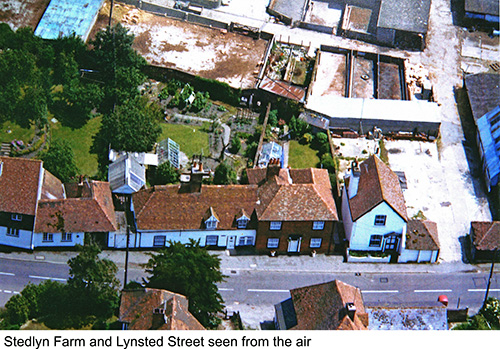 The farm and land were sold in the 1990s to Harry Wood (who died in 2009) who used to work on the farm in earlier times. Harry Wood later sold the farm to developers who built the two modern homes (Ivy Leaf Cottage and Iford Cottage) that now stand there; retaining garages for both Myrtle House (previously Hope Cottage) and neighbouring Ivy Cottage.
The farm and land were sold in the 1990s to Harry Wood (who died in 2009) who used to work on the farm in earlier times. Harry Wood later sold the farm to developers who built the two modern homes (Ivy Leaf Cottage and Iford Cottage) that now stand there; retaining garages for both Myrtle House (previously Hope Cottage) and neighbouring Ivy Cottage.
With some fondness, Myra recalls that George Macey was an amateur magician and all-round entertainer, always enjoying singing (oftentimes around the house).
Myra recollects her father's fond encouragement to continue with some aspect of farming or veterinary work – but Myra considers this was never likely as, when she was a child, she used to hide on slaughter days and could not see animals suffering. Her choice to become a nurse and officer in the army (Queen Alexandra's Nursing Corps) was a source of great pride to Myra's father.
A Passion for Greyhounds - George Archibland Macey
George Macey bred and trained internationally significant greyhounds as a diversification of Mr Macey's other business ventures. An intriguing insight of this passion can be found in the "scrapbook" given to George Macey as a golden wedding anniversary present from his wife, Gladys.
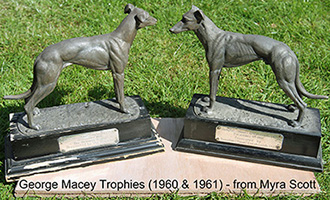
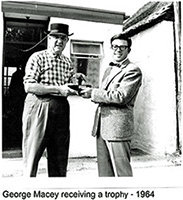
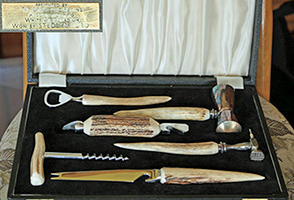
Trophies presented in 1960, 1961, and 1964; Bar set Presentation for winner "Stedlyn Ford" at White City.
More can be learned from the Scrapbook that can be found using this link...
Additional Items from the Macey/Scott Family Album
These images include weddings and christenings, which are so often an important window on fashions and relationships.
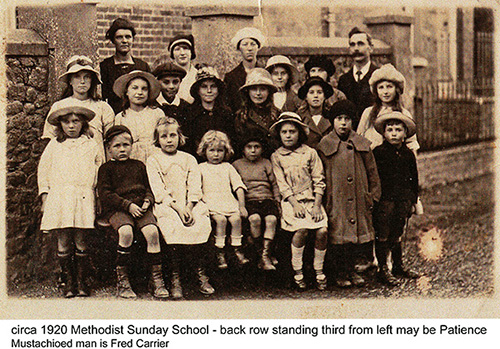
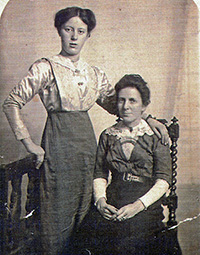
The Methodist Sunday School picture (above left) shows Myra Scott's Aunt Patience, third from left standing in the back row. Patience is standing (above right) above Grandmother "Anna". Her brother, George Archibald, was one of 9 children to George Edwin Macey and Elizabeth Jane (née Berry). G.E.Macey was Myra's Grandfather, who was himself one of 12 children to Charles Macey and Ann Maria (née Peckman).
The Society has drafted two family trees, illustrated by the album shared with us by Myra Scott. Follow these links:-
- One shows the descendant line from Thomas Macey (1803-1882);
- The other is an ancestry tree from Myra Scott, to include some of the Hudson Family. Interestingly, two Macey brothers married two Hudson sisters. George Archibald Macey married Gladys May Hudson; Walter Frederick Macey married Dorothy Eileen Hudson.
Len Scott's care of Lynsted Church Clock (clockface and workings)
Myra has shown us a copy of an early appointment letter for the care of the clock workings. The letter refers to "Michael Cronk" and his responsibility for winding the clock.
April ye i 18th : 1720
An Agreement made between ye Churchwardens of ye Parish of Linstedd and Michall : Cronck for ye saide Michall Cronck : hath Taken ye Parrish Church Clock to hold in Good : Re: paier, for ye Sume of five shillings per : yerare and to Maintaine ye said Clock in Good : Repaier for ye sume of five shillings per yeare All for ye full End and Tearme of Seven Yeares.
Wittness my Hand. (signed) Michaell Cronk
Witnes (signed) Ralph (Maid? Ward?))
[Society Note: Michael Cronk was buried in Lynsted, 29th July 1723; Ralph Ward was married to Anne Curtis in Ospringe, 4th October 1716]
Then, from David Bage's records, we found a letter from Len who explained what was needed to secure the future health of the clock. It was Len, with some friends and colleagues, who led the renovation and re-gilding of the clock face.
[From David Bage's records]
Church Clock Lynsted
Mrytle House
Lynsted4th September 1983
David Bage, Forge Cottage, Lynsted.
Dear David,
Over the last three weeks I have spent daily observations to correct the church clock, lining up the strike to the hour hand and the indicator at the mechanism to be all coincident functions. I am pleased to say I was successful to within three minutes, which is a great improvement to the 15 min plus.
However I feel the clock is in need of a major overhaul many of the bearings require replacement and at the moment to overcome this, extra weights have been used. It solves the problem at present but will increase the wear over a long period.
Leonard Scott. Ref P.T.O.
---
Tower Clocks. Gillett & Johnson (Croydon) Ltd. South Croydon, CR2 0PA. Phone Number 01686 2694; 01 686 0851
The Clock (February 1997)
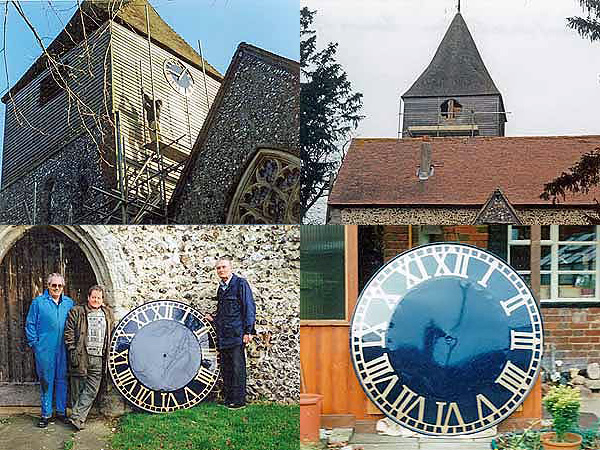 Along with maintainance of the clock workings (illustrated below), Len Scott and others in the Parish re-gilded the clock-face. This needed scaffolding to the tower but also needed forebearance by Myra, whose kitchen was taken over by the clock-face during painting and decoration of the clock-face.
Along with maintainance of the clock workings (illustrated below), Len Scott and others in the Parish re-gilded the clock-face. This needed scaffolding to the tower but also needed forebearance by Myra, whose kitchen was taken over by the clock-face during painting and decoration of the clock-face.
Clock faces have to be seen from the surrounding countryside in the Parish. It isn't until you bring them to ground level that you appreciate just how large these clocks come in at. Len standing to the right with Brian Silcock and Hugh (?can you supply the given name?).
And this had to fit inside Len and Myra's cottage (kitchen table) during renovation!
The letter from Len to Churchwarden, David Bage (above), demonstrates how much time Len spent with the clock to ensure its best performance. Len was a skilled craftsman with everything from wrist watches to these major tower clocks.
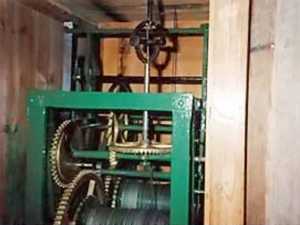
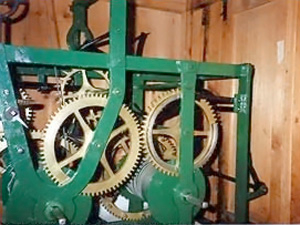
With the scaffolding up, Len took a few snaps of the village that give a sense of how the church building dominates the village.
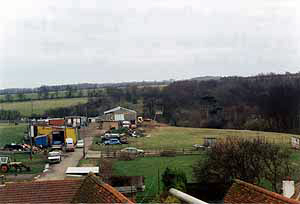

And, finally, Dr Who in Lynsted...
Discovered amongst old comics from around 1970 that once belonging to Myra's children, who would have been very keenly aware of this local celebrity, we were shown an article from the Dr Who Magazine that documented the Lynsted Lodge connection with the inventor of the Daleks.
"TWO OF THE DALEKS LIVE IN MY FRONT DRIVE
 The Daleks came into my life in 1963, bringing with them the first taste of fame that Kate, my wife, and I had experienced,' says Terry Nation, pictured here with Daleks outside his home near Sittingbourne, Kent.
The Daleks came into my life in 1963, bringing with them the first taste of fame that Kate, my wife, and I had experienced,' says Terry Nation, pictured here with Daleks outside his home near Sittingbourne, Kent.
I was invited to write the second Dr Who serial, and having read the brief could only predict disaster for the celebrated Doctor. How could this crazy fellow, who passed his time travelling all over the Galaxy in a police box, last more than a dozen episodes? I was close to turning down the offer, but then my not very creditable sentiments took over: take the money and fly like a thief.
Given the power of hindsight? I would like to have created .a more romantic setting for the birth of the Daleks. Edgar Rice Burroughs did spectacularly well, dreaming up Tarzan whilst lazing in his garden hammock.
I had no such rich picture, so I was forced to invent my story afterwards. In a desperate attempt to satisfy persistent journalists, who wanted some profound explanation for my naming the Daleks, I told them that I'd been inspired by the letters on a volume of an encyclopaedia. But the fact is that no encyclopaedia in print covers those letters DAL-LEK. Anyone checking the facts could have found me out.
My only source of inspiration came from TV — a wholesome case of the medium creating its own new image. I'd been watching a performance by the Georgian State Dancers and they seemed to me to be gliding across the floor, their feet invisible under long costumes. It was the strangeness of this movement I wanted to recapture in the Daleks: creatures with no apparent motive power.
As for the name, it simply rolled off the typewriter. Once the blueprint for the Daleks — "hideous machine-like creatures . . . legless . . . with no human features" had appeared on pager Ray Cusick, the programme designer, took over and he was the man who must take the credit for the Daleks' startling pepper-pot design. It wasn't until I saw them that I realised they were just what I'd had in mind from the start.
There must have been magic in 1963. Like everything else I touched that year, the Daleks went down like a house on fire. I was amazed by my own luck. Suddenly I was in demand from all sides, beseiged by offers to write comedies, plays, science fiction. We worked out that there was some work of mine shown on television for 4o weeks out of 52 that year. Fortunately I work very fast, and work best under pressure. The Dr Who scripts became my Saturday job. They were written one a week, each Saturday.
It would be wrong to claim, as many people have, that I've grown wealthy on the strength of the Daleks. I've been earning my living as a writer for nearly 20 years, and of that time perhaps three months in all have been devoted to Who scripts. But I don't resent the inextricable link with the Daleks, who have brought me privileged recognition and provided my family with the gilt on the gingerbread.
The revenue from the Dalek merchandise, 132 products in all, included jelly babies, wallpaper, drawing books, children's slippers and dressing-up outfits, and it brought in money "beyond the dreams of avarice." My family had taken a long time to accept the fact that sitting at a typewriter constituted an honest living, and now here I was receiving cheques without working for them at all!
I have been asked more times than I could count to explain the success of the Daleks in philo-sophical terms. The answer is very simple: kids love to be frightened. To them it's like creeping up to the top of the stairs in the dark, which is surely a healthy emotion.
Life with the Daleks has not been without problems. Their continued existence means that I find it impossible to write another successful monster into Dr Who. It would be difficult and foolish to rival the Daleks. Then, in the first series I wrote, I killed off the Daleks completely, having no idea popular demand would insist on their return. Nobody has ever killed off their brainchild so thoroughly as I annihilated mine, unless it was Conan Doyle, trying to rid himself of Sherlock Holmes. Fortunately the trusty Tardis came to the rescue: I brought the Daleks back in a time era before the date they were exterminated!
To begin with we received sackfuls of readers' letters posing impossible problems. Children were always much smarter than I was at pointing out anomalies in the plot. I'd scratch my head and eventually write back: "I think you must be forgetting the secret formula X divided by 375 multiplied by 279, which I'm sure you'll agree over-comes your objection fully." '

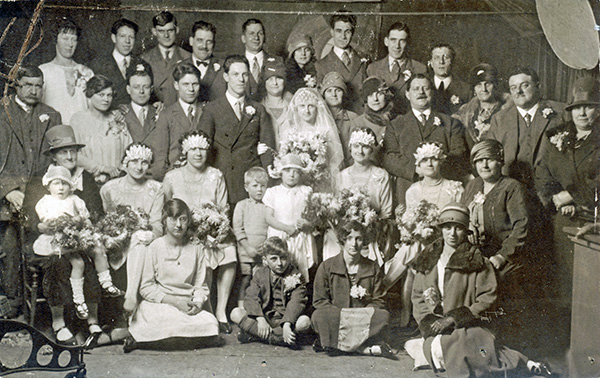
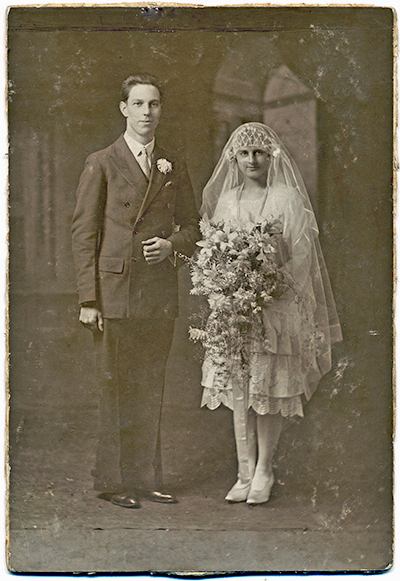 Bride to bridegroom, gold signet ring; bridegroom to bride, going away coat of dove grey velour trimmed with fur; bride's mother, eiderdown and feather bed; bride's father, bed outfit and wedding breakfast; bridegroom's mother, armchair and crockery; bridegroom's father, curb [harness piece]; staff of Messrs. F.W.Woolworth's and Co., blankets; Ivy, clock and vases; Dolly, sideboard cloth; Vern, cruet; aunt Flo, oak table and pedestal; Mr. and Mrs G. Hudson, set of jugs; Mr. and Mrs. B. Albrow, oval mirror; Eva and Fred, tea cosy; Kath and Jim, table cover; Mr. and Mrs. Penn, jam dish; Miss N. Turmaine, biscuit barrel; Mr. and Mrs. Beer, blankets; Mr. and Mrs. V.Hudson, toilet set; Mr. and Mrs. Gee and family, cutlery; Mr. and Mrs. Coleman, duchess set; Miss Whelan, pillow slips; Mr. and Mrs Copp, quilt; Miss Copp, nightdress case; Mr. and Mrs Skitter and daughter, dinner service; Miss Watton, powder bowl; baby Stella, bath towels; Mr and Mrs Dave, teacloths; Mr. and Mrs. Hudson, case of spoons; Mr. and Mrs Hones, curtain and bouquet; Mr. and Mrs. Chidwick, oak tray; Ena and May, afternoon table-cloth; Miss Prescott, afternoon tablecloth; Mr. T. Beer, pictures; Miss D. May, duchess set; Mr. and Mrs. A. Penn, trinket set; Mr. and Mrs. W.Albrow, cheque; Miss D.Albrow, table cloths; Lily, coal cauldron and tongs; Mr. and Mrs. Thomson, cake stand and duchess set; Mr. and Mrs. Cadman, cake knife; Miss Copestick and Mrs. Copestick, Wedgewood teapot; Mr. and Mrs. Bugg, wedding veil; Mr. an Mrs. Ansley, tea spoons; Mr. and Mrs. Mant, sheets; Woolworth and Co., cheque; Mr and Mrs Thompson, bread knife; Walter enlargement of photo of the bride and bridegroom; Percy, companion set; Hilda and Fred, flower epergne; Rene, set of saucepans; Mr. and Mrs. C. Macey and daughter, cushion covers; Mr. and Mrs. Saunders, kitchen table; Mr. and Mrs. Stockport, crockery; Mr. and Mrs. Stevens, kettle and case of spoons; Mr. and Mrs. Macey, clock; Miss Macey, set of fruit dishes; Tony, table centre; Mr. and Mrs. Chesson, duchesse set; Mr. and Mrs. J. Chesson, silver salt cellars and spoons; Mr. and Mrs. Chesson, bread board; Mr. and mgrs. Payne, sideboard cloth; Miss S. Jull, tablecloth; Mr. and Mrs. Payne, cushion and fire tidy; Miss E. Jull, table centre; Mr. and Mrs. Haughton, case of knives; Mrs. Lavars, fruit dishes; Allen, Gladys and Jacky, pails; Mr. Gordon and Mrs. Shrubsall, half tea service; and Miss E. Sandy, hand brush tidy.
Bride to bridegroom, gold signet ring; bridegroom to bride, going away coat of dove grey velour trimmed with fur; bride's mother, eiderdown and feather bed; bride's father, bed outfit and wedding breakfast; bridegroom's mother, armchair and crockery; bridegroom's father, curb [harness piece]; staff of Messrs. F.W.Woolworth's and Co., blankets; Ivy, clock and vases; Dolly, sideboard cloth; Vern, cruet; aunt Flo, oak table and pedestal; Mr. and Mrs G. Hudson, set of jugs; Mr. and Mrs. B. Albrow, oval mirror; Eva and Fred, tea cosy; Kath and Jim, table cover; Mr. and Mrs. Penn, jam dish; Miss N. Turmaine, biscuit barrel; Mr. and Mrs. Beer, blankets; Mr. and Mrs. V.Hudson, toilet set; Mr. and Mrs. Gee and family, cutlery; Mr. and Mrs. Coleman, duchess set; Miss Whelan, pillow slips; Mr. and Mrs Copp, quilt; Miss Copp, nightdress case; Mr. and Mrs Skitter and daughter, dinner service; Miss Watton, powder bowl; baby Stella, bath towels; Mr and Mrs Dave, teacloths; Mr. and Mrs. Hudson, case of spoons; Mr. and Mrs Hones, curtain and bouquet; Mr. and Mrs. Chidwick, oak tray; Ena and May, afternoon table-cloth; Miss Prescott, afternoon tablecloth; Mr. T. Beer, pictures; Miss D. May, duchess set; Mr. and Mrs. A. Penn, trinket set; Mr. and Mrs. W.Albrow, cheque; Miss D.Albrow, table cloths; Lily, coal cauldron and tongs; Mr. and Mrs. Thomson, cake stand and duchess set; Mr. and Mrs. Cadman, cake knife; Miss Copestick and Mrs. Copestick, Wedgewood teapot; Mr. and Mrs. Bugg, wedding veil; Mr. an Mrs. Ansley, tea spoons; Mr. and Mrs. Mant, sheets; Woolworth and Co., cheque; Mr and Mrs Thompson, bread knife; Walter enlargement of photo of the bride and bridegroom; Percy, companion set; Hilda and Fred, flower epergne; Rene, set of saucepans; Mr. and Mrs. C. Macey and daughter, cushion covers; Mr. and Mrs. Saunders, kitchen table; Mr. and Mrs. Stockport, crockery; Mr. and Mrs. Stevens, kettle and case of spoons; Mr. and Mrs. Macey, clock; Miss Macey, set of fruit dishes; Tony, table centre; Mr. and Mrs. Chesson, duchesse set; Mr. and Mrs. J. Chesson, silver salt cellars and spoons; Mr. and Mrs. Chesson, bread board; Mr. and mgrs. Payne, sideboard cloth; Miss S. Jull, tablecloth; Mr. and Mrs. Payne, cushion and fire tidy; Miss E. Jull, table centre; Mr. and Mrs. Haughton, case of knives; Mrs. Lavars, fruit dishes; Allen, Gladys and Jacky, pails; Mr. Gordon and Mrs. Shrubsall, half tea service; and Miss E. Sandy, hand brush tidy.
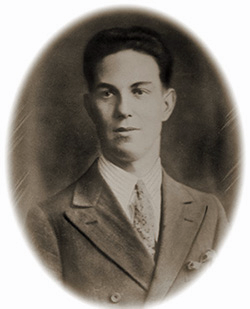 These portrait photographs were a gift from Walter Frederick Macey (brother of George Archibald, who married Gladys May Hudson's younger sister, Dorothy Eileen Hudson on 21st September 1935 in St. Andrews Church at Buckland, now part of Dover (see below).
These portrait photographs were a gift from Walter Frederick Macey (brother of George Archibald, who married Gladys May Hudson's younger sister, Dorothy Eileen Hudson on 21st September 1935 in St. Andrews Church at Buckland, now part of Dover (see below). 